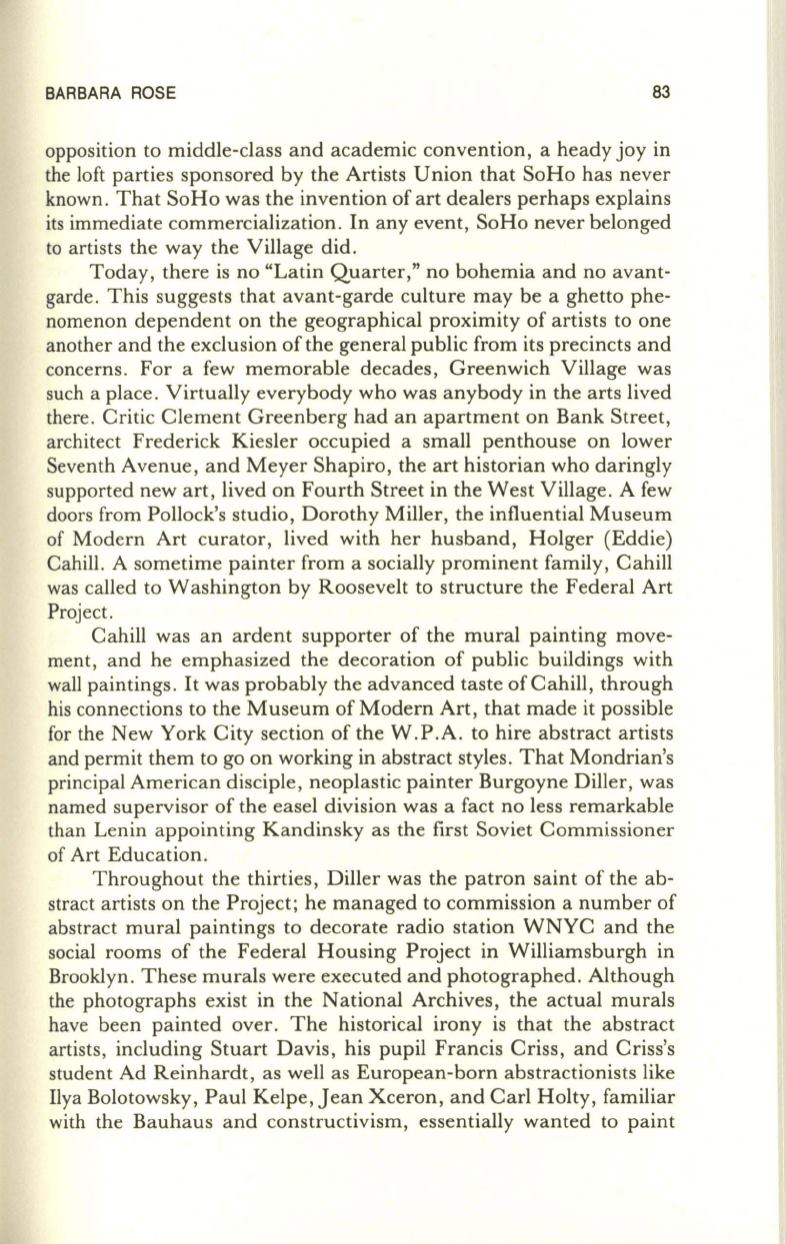
BARBARA ROSE
83
opposition to middle-class and academic convention, a heady joy in
the loft parties sponsored by the Artists Union that SoHo has never
known. That SoHo was the invention of art dealers perhaps explains
its immediate commercialization. In any event, SoHo never belonged
to artists the way the Village did .
Today, there is no "Latin Quarter," no bohemia and no avant–
garde. This suggests that avant-garde culture may be a ghetto phe–
nomenon dependent on the geographical proximity of artists to one
another and the exclusion of the general public from its precincts and
concerns. For a few memorable decades, Greenwich Village was
such a place. Virtually everybody who was anybody in the arts lived
there . Critic Clement Greenberg had an apartment on Bank Street,
architect Frederick Kiesler occupied a small penthouse on lower
Seventh Avenue, and Meyer Shapiro, the art historian who daringly
supported new art, lived on Fourth Street in the West Village . A few
doors from Pollock's studio , Dorothy Miller, the influential Museum
of Modern Art curator, lived with her husband, Holger (Eddie)
Cahill. A sometime painter from a socially prominent family, Cahill
was called to Washington by Roosevelt to structure the Federal Art
Project.
Cahill was an ardent supporter of the mural painting move–
ment, and he emphasized the decoration of public buildings with
wall paintings. It was probably the advanced taste of Cahill , through
his connections to the Museum of Modern Art, that made it possible
for the New York City section of the W .P .A . to hire abstract artists
and permit them to go on working in abstract styles. That Mondrian's
principal American disciple, neoplastic painter Burgoyne Diller, was
named supervisor of the easel division was a fact no less remarkable
than Lenin appointing Kandinsky as the first Soviet Commissioner
of Art Education.
Throughout the thirties, Diller was the patron saint of the ab–
stract artists on the Project; he managed to commission a number of
abstract mural paintings to decorate radio station WNYC and the
social rooms of the Federal Housing Project in Williamsburgh in
Brooklyn . These murals were executed and photographed. Although
the photographs exist in the National Archives, the actual murals
have been painted over. The historical irony is that the abstract
artists, including Stuart Davis, his pupil Francis Criss , and Criss's
student Ad Reinhardt, as well as European-born abstractionists like
Ilya Bolotowsky, Paul Kelpe, Jean Xceron, and Carl Holty, familiar
with the Bauhaus and constructivism, essentially wanted to paint


